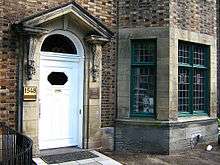Baháʼí Faith in North America
The Baháʼí Faith is a diverse and widespread religion founded by Baháʼu'lláh in the 19th century in Iran. Baháʼí sources usually estimate the worldwide Baháʼí population to be above 5 million.[1] Most encyclopedias and similar sources estimate between 5 and 6 million Baháʼís in the world in the early 21st century.[2][3] The religion is almost entirely contained in a single, organized, hierarchical community, but the Baháʼí population is spread out into almost every country and ethnicity in the world, being recognized as the second-most geographically widespread religion after Christianity.[2] See Baháʼí statistics.
| Part of a series on |
| Baháʼí Faith |
|---|
 |
|
Central figures |
|
History |
|
Other topics |
United States
Modern community
In December 1999, the National Spiritual Assembly of the United States stated that out of approximately 140,000 adult (15 and over) members on the rolls, only 70,000 had known addresses.[4] The American Religious Identity Survey (ARIS) conducted in 2001, with a sample size of 50,000, estimated that there were 84,000 self-identifying adult (21 and over) Baháʼís in the United States.[5] The Association of Religion Data Archives estimated there were some 525,000 Baháʼís in 2005[6] however statistics in Feb 2011 show 175,000[7] excluding Alaska and Hawai'i.
Although a majority of Americans are Christians, Baháʼís make up the second-largest religious group in South Carolina as of May 2014.[8] And based on data from 2010, Baháʼís were the largest minority religion in 80 counties out of the 3143 counties in the country.[9] While early fictional works relating the religion occurred in Europe a number of them have appeared in the United States since the 1980s, sometimes in mass media - see Baháʼí Faith in fiction.
Canada

The Canada 2011 Census National Household Survey recorded 18,945 Baháʼís.[11] The Canadian Baháʼí Community, according to its official website[12] consists of some 30,000 members across approximately 1200 communities throughout the 13 Canadian Provinces and Territories. According to the same source, the Canadian community is quite diverse: "There are French-speaking and English-speaking Baháʼís, and more than 18% of Canadian Baháʼís come from First Nations and Inuit backgrounds; another 30% are recent immigrants or refugees."
The Canadian community is one of the earliest western communities, at one point sharing a joint National Spiritual Assembly with the United States, and is a co-recipient of ʻAbdu'l-Bahá's Tablets of the Divine Plan. The first North American woman to declare herself a Baháʼí was Mrs. Kate C. Ives, of Canadian ancestry, though not living in Canada at the time. Moojan Momen, in reviewing "The Origins of the Baháʼí Community of Canada, 1898–1948" notes that "the Magee family... are credited with bringing the Baháʼí Faith to Canada. Edith Magee became a Baháʼí in 1898 in Chicago and returned to her home in London, Ontario, where four other female members of her family became Baháʼís. This predominance of women converts became a feature of the Canadian Baháʼí community..."[13]
Statistics Canada reports 14,730 Baháʼís from 1991 census data and 18,020 in those of 2001.[14] However the Association of Religion Data Archives (relying on World Christian Encyclopedia) estimated almost 46,600 Baháʼís in 2005.[6] Some editions of the Canadian Baháʼí News are available.[15]
Mexico
The Baháʼí Faith in Mexico begins with visits of Baháʼís before 1916.[16] In 1919 letters from the head of the religion, ʻAbdu'l-Bahá, were published mentioning Mexico as one of the places Baháʼís should take the religion to.[17] Following further pioneers moving there and making contacts the first Mexican to join the religion was in 1937, followed quickly by the first Baháʼí Local Spiritual Assembly of all Latin America being elected in 1938.[16][18] With continued growth the National Spiritual Assembly was first elected in 1961.[18][19] The Association of Religion Data Archives (relying on World Christian Encyclopedia) estimated almost 38,000 Baháʼís in 2005.[6]
Central America
Belize
The Association of Religion Data Archives estimates there were 7,776 Baháʼís in Belize in 2005, or 2.5% of the national population. If correct, the Association of Religion Data Archives' estimates suggest this is the highest proportion of Baháʼís in any country.[20] Their data also states that the Baháʼí Faith is the second most common religion in Belize, followed by Hinduism (2.0%) and Judaism (1.1%).[21] However the 2010 Belize Population Census recorded 202 Baháʼís out of a total population of 304,106,[22][23] yielding a proportion of 0.066%, not 2.5%.
Panama
The history of the Baháʼí Faith in Panama begins with a mention by ʻAbdu'l-Bahá in the book Tablets of the Divine Plan, published in 1919; the same year, Martha Root made a trip around South America and included Panama on the return leg of the trip up the west coast.[24] The first pioneers began to settle in Panama in 1940.[18] The first Baháʼí Local Spiritual Assembly of Panama, in Panama City, was elected in 1946,[16] and the National Spiritual Assembly was first elected in 1961.[19] The Baháʼís of Panama raised a Baháʼí House of Worship in 1972.[25] In 1983 and again in 1992, some commemorative stamps were produced in Panama[26][27] while the community turned its interests to the San Miguelito and Chiriquí regions of Panama with schools and a radio station.[28] The Association of Religion Data Archives estimated there were some 41,000 Baháʼís in 2005[6] while another sources places it closer to 60,000.[29]
See also
- Category:American Bahá'ís
- Category:Canadian Bahá'ís
- Baháʼí Faith and Native Americans
- Baháʼí statistics
- Religions by country
- Islam by country
- Judaism by country
- Hinduism by country
- Christianity by country
- Sikhism by country
- No Faith by Country
Notes
- Baháʼí International Community (2006). "Worldwide Community". Baháʼí International Community. Archived from the original on 13 June 2006. Retrieved 31 May 2006.
- "Worldwide Adherents of All Religions by Six Continental Areas, Mid-2002". Encyclopædia Britannica. Encyclopædia Britannica. 2002. Retrieved 31 May 2006.
- adherents.com (2002). "Major Religions of the World Ranked by Number of Adherents". adherents.com. Retrieved 28 August 2005.
- National Teaching Committee (12 December 1999). "Issues Pertaining to Growth, Retention and Consolidation in the United State; A Report by the National Teaching Committee of the United States". National Spiritual Assembly of the Baháʼís of the United States. Retrieved 8 February 2014.
- "Largest Religious Groups in the United States of America". Adherents.com. 2013. Archived from the original on 20 August 2018. Retrieved 8 February 2014.
- "Most Baha'i Nations (2005)". QuickLists > Compare Nations > Religions >. The Association of Religion Data Archives. 2005. Retrieved 16 September 2012.
- "Quick Facts and Stats". Official website of the Baha'is of the United States. National Spiritual Assembly of the Baha'is of the United States. 11 June 2014. Archived from the original on 11 June 2014. Retrieved 24 April 2017.
- Wilson, Reid. "The Second-Largest Religion in Each State". The Washington Post.
- "Religion Census Newsletter" (PDF). RCMS2010.org. Association of Statisticians of American Religious Bodies. March 2017. Retrieved 17 March 2017.
- Montreal Baháʼí Community: Locations.
- "2011 National Household Survey: Data tables". Statistics Canada. Retrieved 17 September 2016.
- Canadian Baháʼí News, Bahai.works, 2018
- Lamb, Artemus (November 1995). The Beginnings of the Baháʼí Faith in Latin America:Some Remembrances, English Revised and Amplified Edition. West Linn, Oregon: M L VanOrman Enterprises.
- ʻAbbas, ʻAbdu'l-Bahá (April 1919). Tablets, Instructions and Words of Explanation. Mirza Ahmad Sohrab (trans. and comments).
- "Comunidad Baháʼí de México". National Spiritual Assembly of the Baháʼís of Mexico. 2012. Retrieved 25 February 2012.
- Hassall, Graham; Universal House of Justice. "National Spiritual Assemblies statistics 1923–1999". Assorted Resource Tools. Baháʼí Library Online. Retrieved 10 May 2009.
- "Most Baha'i Nations (2005)". The Association for Religion Data Archives. Retrieved 21 November 2015.
- "Belize: Religious Adherents (2010)". The Association for Religion Data Archives. Retrieved 21 November 2015.
- "2010 Census of Belize Overview". 2011. Archived from the original on 29 May 2012. Retrieved 23 April 2017.
- "2010 Census of Belize Detailed Demographics of 2000 and 2010". 2011. Retrieved 23 April 2017.
- Yang, Jiling (January 2007). In Search of Martha Root: An American Baháʼí Feminist and Peace Advocate in the early Twentieth Century (pdf) (Thesis). Georgia State University. Retrieved 30 June 2008.
- House of Justice, Universal; compiled by W. Marks, Geoffry (1996). Messaged from the Universal House of Justice: 1963-1986: The Third Epoch of the Formative Age. Wilmette, Illinois: Baháʼí Publishing Trust. p. 212. ISBN 0-87743-239-2.
- maintained by Tooraj, Enayat. "Baháʼí Stamps". Baháʼí Philately. Baháʼí Library Online. Retrieved 30 June 2008.
- maintained by Tooraj, Enayat. "Baháʼí Stamps". Baháʼí Philately. Baháʼí Library Online. Retrieved 30 June 2008.
- International Community, Baháʼí (October–December 1994). "In Panama, some Guaymis blaze a new path". One Country. 1994 (October–December). Archived from the original on 2 August 2014. Retrieved 27 November 2015.
- "Panama". WCC > Member churches > Regions > Latin America > Panama. World Council of Churches. 1 January 2006. Archived from the original on 8 July 2008. Retrieved 1 July 2008.
Further reading
- Will C. Van Den Hoonaard (1996). The Origins of the Baháʼí Community of Canada: 1898 -1948. Wilfrid Laurier Univ. Press. p. 356. ISBN 978-0-88920-272-6.
- Academic American Encyclopedia. Grolier Academic Reference. 1998. ISBN 0-7172-2068-0.
- Bowker, John W., ed. (1997). The Oxford Dictionary of World Religions. Oxford University Press. ISBN 0-19-213965-7.
- Chernow, Barbara A.; Vallasi, George A. (1993). The Columbia Encyclopedia. Houghton Mifflin. ISBN 0-395-62438-X.
- Lynn Echevarria-Howe (published as Lynn Echevarria) (2011). Life Histories of Baha'I Women in Canada: Constructing Religious Identity in the Twentieth Century. Series 7, theology and religion, American University Studies. 316. Peter Lang Publishing Inc. ISBN 9781433114571.
- The Encyclopedia of Islam, New Edition. Brill. 1960. Ref DS37.E523.
- Hinnells, John R. (2000). The New Penguin Handbook of Living Religions (second ed.). Penguin. ISBN 0-14-051480-5.
- Jones, Lindsay, ed. (2005). Encyclopedia of Religion (second ed.). MacMillan Reference Books. ISBN 0-02-865733-0.
- O'Brien, Joanne; Palmer, Martin (2005). Religions of the World. Facts on File. ISBN 0-8160-6258-7.
- Oliver, Paul (2002). Teach Yourself World Faiths. McGraw-Hill. ISBN 0-07-138448-0.
- Roof, Wade C. (1993). A Generation of Seekers: Spiritual Journeys of the Baby Boom Generation. HarperCollins. ISBN 0-06-066964-0.
- Smith, Jonathan Z.; American Academy of Religion (1995). The Harpercollins Dictionary of Religion. HarperCollins. ISBN 0-06-067515-2.
- Stockman, Robert (1985). Baha'i Faith in America: Origins 1892-1900. Wilmette, Ill.: Baha'i Publishing Trust of the United States. ISBN 978-0-87743-199-2. Archived from the original on 23 July 2008. Retrieved 26 November 2014.
- Stockman, Robert (2002). Baha'i Faith in America, The: Early Expansion, 1900-1912 Volume 2. Wilmette, Ill.: George Ronald. ISBN 978-0-87743-282-1. Archived from the original on 17 January 2013. Retrieved 26 November 2014.
- Stockman, Robert (2012). Abdu'l-Baha in America. Wilmette, Ill.: Baha'i Publishing Trust of the United States. ISBN 978-1-931847-97-1. Archived from the original on 17 January 2013.
- The World Book Encyclopedia. World Book Inc. 2002. ISBN 0-7166-0103-6.
External links
- Baháʼí World Statistics
- adherents.com – A website about religious adherents of numerous faiths
- adherents.com – Specific compiled stats on Baháʼí communities